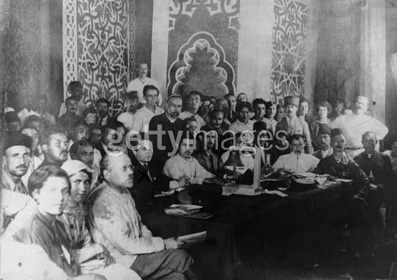 |
Peoples' movements and protests |
 |
|
MobilizationsThe republican movementThe Nordic popular movevment cultureThe Communist movementThe Islamist movementThe Global Justice MovementBack to Total movementsBack to main page |
The communist movement
Notions of parallel hierarchies have haunted popular movements for centuries. Such have been able to carry a resistance through adversity, which e.g. the Chinese secret societies testify. Cathars, Freemasons, Carbonari and Christian, Muslim and Hindu sects are other examples. The most widespread and successful example of the twentieth century, however, was the Communists, who, like the medieval Fatimids, had the advantage of being able to control the resources and state power of an entire country. The Communist Global Organization – Communist International, CI – was founded by the alliance of national and labor movements that carried out a revolution in Russia against its incompetent and oppressive regime in 1917. To protect the Russian state from hostile attacks, an organization was built with the strategy of striking first, by supporting anti-colonial movements and – to a much lesser extent – labour movements. For it quickly became clear that the appeal among labour movements was limited, largely confined to colonial and semi-peripheral countries. Few workers in the developed countries identified with the Russian state. But so did so many more anti-colonial movements, which saw Russian aspirations as completely parallel to their own. The picture above is from the so-called the People’s Congress in Baku in 1920 where anti-colonial movements decided to help each other. The best known example was the support to the Chinese national movement. Some technical help and resources quickly got completely into the background by the domestic expertise and the domestic resources that were mobilized thanks to the identification with the successful Russian example. A global identity and experience of solidarity helped substantially to destroy classical colonialism in just a few decades, through revolutions in China and Vietnam, through peasant movements in India and the Philippines, and not least by defeating the most aggressive form of European self-glorification, Nazism. Incidentally, it was the latter struggle that created the only mass base communism ever won in a developed country, in France, Italy and Czechoslovakia. When the goal was achieved, the raison d'être of the CI ceased and the organization was disbanded in 1943. The communist identity continued to live a kind of shadowy existence for a few decades. With some positive effects in e.g. South Africa where colonial structures continued to survive, and with more conservative as in Europe. Some positive initiatives could be taken, e.g. the so-called world youth festivals where not least anti-colonial activists could meet. Below is a picture from the World Youth Festival in Moscow 1961. But on the whole, the hierarchical legacy guaranteed that it all stagnated to reflect the interests of the Russian state-bourgeoisie instead of some kind of popular movement. When labour and peace movements mobilized in the 1960s, and when environmental movements and movements for the commons mobilized in the 1970s, the Communists were irrelevant.
|

